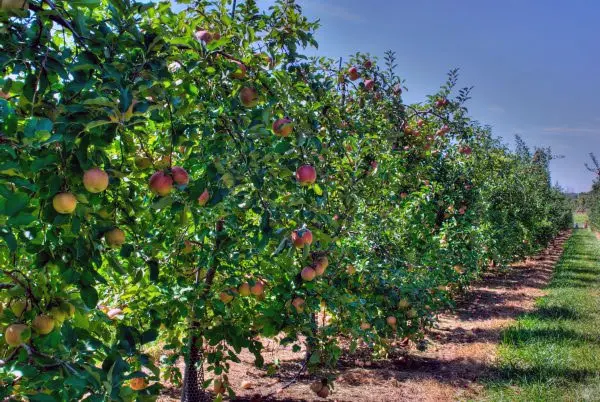For many years, gardeners have debated which type of orchard is better: standard or dwarf trees.
Both have their advantages and disadvantages.
My neighbor once complained, “There are pears, but I can’t reach them.” Indeed, harvesting fruit from a tree as tall as a poplar is no easy feat; you can’t do it without a ladder. And sometimes, even a ladder isn’t enough. Australian farmers joke, “By the time the gardener climbs the ladder to the tree, money is falling out of his pockets…”
Of all the gardening tasks, harvesting is the most expensive, consuming 70-80% of total costs.
Dwarf trees grow to a height of 6.5 to 8 feet. For an average-height person, it’s easy to reach the fruit with just an outstretched arm. These shorter plants bear fruit as early as the second year after planting. While the yield is modest—about 3 to 5.5 pounds per tree—it’s still a harvest.
For example, on a plot of 1,300 to 1,600 square feet, you can fit 20 to 25 dwarf trees, while only 10 standard trees would fit. The following year, the dwarf trees can produce 88 to 110 pounds of fruit, while the standard trees of the same age might yield nothing. Additionally, the fruit from dwarf trees is larger and of excellent quality.
Currently, commercial orchards predominantly feature dwarf and semi-dwarf trees. Hobbyist gardeners are also reducing the height of their saplings. However, not everyone can afford dwarf trees, as they are challenging to grow and often expensive.
You can grow your own semi-dwarf saplings.
At experimental stations and nurseries, they cultivate semi-dwarf rootstocks for apple trees—bushy plants. These include red-leafed paradises, semi-dwarf rootstocks like Dushen and others. The bushes are hilled up high so that the shoots can develop their own roots. They are then separated, planted, and grafted with cuttings from cultivated varieties. This results in “two-tiered” saplings.
When rootstocks are hard to come by, you can manage with a single unrooted shoot. A cutting from a paradise tree is grafted onto a standard seedling, known as an intercalary. The following year, on the paradise rootstock, you graft a cutting of the desired variety “in a cleft.” This graft should be placed 7 to 8 inches away from the first grafting site, resulting in a “three-tiered” sapling.
During this operation, it’s crucial to maintain cleanliness, avoiding contact with the cut surfaces, and quickly sealing them with garden wax. The grafting site should be wrapped with plastic tape. Success depends on the precise alignment of the cambium layers and the quality of the cuttings.
How to obtain a dwarf pear sapling?
The best rootstock for pears is the common rowan. It is winter-hardy and adaptable to various soil conditions. However, not all varieties thrive on it, as some do not take well.
You can also graft pears onto chokeberries (black-fruited rowan). Just keep in mind that the thickness of the graft should significantly exceed that of the rootstock. For these semi-dwarf pears, supports or wire trellises are necessary.
Dwarf pears can also be grafted onto Japanese quince, serviceberry, cornelian cherry, and hawthorn, although they perform better on common rowan.
On felted cherries, you can graft cuttings of common cherries, plums, cherry plums, and sweet cherries.
Interestingly, if you graft a black-fruited variety onto a common rowan, the tree will grow in a palm-like shape, with a fan-shaped crown adorned with black clusters.
In brief, how to plant dwarf trees.
The root collar should not be buried, especially in clay soils. The root system of these trees is close to the soil surface, making it vulnerable to frost damage. To prevent this, cover the root system within the crown with soil, peat, or compost. Snow retention in winter is also beneficial.
Trees grown on intercalary rootstocks should be covered with peat or soil before the ground freezes to protect the intercalary (the cutting).

